Keeping an eye on the usual suspects: Dublin Castle’s ‘Personalities Files’, 1899–1921
Published in 18th–19th - Century History, 20th-century / Contemporary History, Features, Issue 6 (Nov/Dec 2006), Volume 14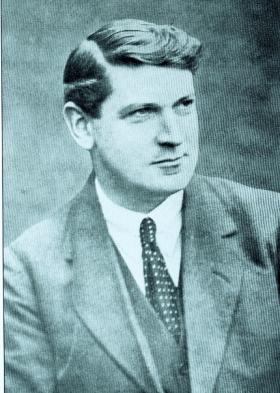
The documents provide a rich source of information on leading figures such as Michael Collins.
Beginning in the late nineteenth century, Dublin Castle’s ‘Personalities Files’ span the emergence of Sinn Féin, the Easter Rising and the War of Independence, with the largest number relating to the period 1917–20. As might be expected, the documents provide a rich source of information on leading figures such as Michael Collins and Eamon de Valera—detailing their movements, contacts with other revolutionaries, public speeches, private correspondence and legal struggles with the authorities—but their value is enhanced by the fact that many of the files concern lesser-known political activists, individuals who never became household names but were crucial to the success of the republican movement. Perhaps the most significant aspect is the light that they shed on the security forces and Dublin Castle during these final years of revolutionary violence and administrative chaos.
Origins
How was the intelligence in the Personalities Files gathered? For what purpose? What does it tell us about law and order in Ireland and the administration’s attempts to contain the growing social unrest and political violence of the period? What do the files reveal about the outlook of the politicians, officials and Crown forces tasked with suppressing the Irish revolution? What do they tell us about the strategies adopted by republicans to overthrow British rule?
The documents, only declassified during the past decade, form a small section of Colonial Office class 904 (better known as ‘the Dublin Castle Records’), a series of records of the British administration in Ireland held by the National Archives in London. They originally formed part of the records of the Crimes Special Branch of the Royal Irish Constabulary (RIC), one of two police forces operating in Ireland at this time. The RIC was responsible for law and order throughout the country, while the Dublin Metropolitan Police (DMP) had responsibility for Dublin and the surrounding metropolitan area. It was the latter’s G Division (or Special Branch) that would fight the IRA for control of the streets of Dublin during the War of Independence. The Personalities Files were assembled by the RIC, not the DMP, but include many documents generated by ‘the G’ because of Dublin’s role as the administrative centre of the republican movement. Given the dearth of surviving material on the DMP, the Personalities Files represent an important source for its crucial G Division.
Like the DMP, the RIC operated a discrete section tasked with monitoring and prosecuting subversives: the Crimes Special Branch (more commonly known as Special Branch). Both special branches shared intelligence but maintained separate staffs and records. Contrary to popular belief, neither was a particularly impressive organisation. Even at the height of the IRA’s campaign, ‘the G’ employed fewer than two dozen men exclusively dedicated to political work, while the RIC’s Special Branch consisted not of a nationwide detective force along the lines of Scotland Yard but a confidential records office based in Dublin Castle, staffed by several clerks, a detective inspector and a chief inspector. The vast bulk of intelligence gathered by Special Branch was collected by ordinary RIC men throughout the country, and forwarded to Crimes Special Branch’s small office in Dublin Castle. Until the final year of Dublin Castle’s rule, there was no ‘secret service’ in Ireland; Special Branch did not run undercover agents, rarely recruited informers and made little effort to penetrate the organisations of its enemies. The documents gathered here demonstrate the old-fashioned methods employed by the police:
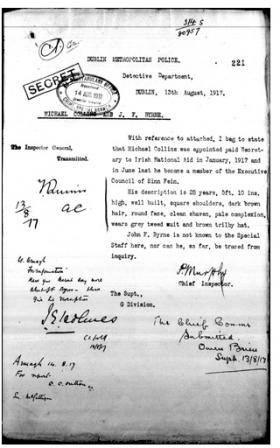
An early reference to Michael Collins. (National Archives, Kew)
republican premises were kept under observation, train stations and other public places were watched, suspects were shadowed from town to town, and their speeches were recorded by policemen who rarely disguised their identity.
The Personalities Files were generated for a variety of purposes: to gather intelligence on revolutionaries, to compile evidence for their prosecution, to respond to the many inquiries about suspected republican sympathisers that Dublin Castle received, and to justify the dismissal of republicans from public employment. The series documents the correspondence not only of the police but of the offices of the chief secretary, under-secretary, lord lieutenant, government departments such as the General Post Office, and various sections of the Irish and British security forces, including Scotland Yard and MI5. The comments appended to the files by these officials offer revealing insights into the political rationale behind Dublin Castle’s decisions and the legal and bureaucratic difficulties they encountered in securing prosecutions.
The enemy within
The largest proportion of files relate to public servants, demonstrating that teachers, clerks, telephonists, excise officers and even postmen were viewed by the regime as potentially dangerous enemies within. The outspoken Borrisoleigh schoolteacher Thomas Bourke was ‘a disgrace & a danger to the state’, suspected of ‘instilling disloyalty into his pupils’. The Strabane postman Cornelius Boyle delivered more than the mail: ‘on his travels . . . he is stirring up revolts in the minds of the young men on his walk every day’. Schoolteacher Michael Thornton, a ‘devilish ruffian’, was dismissed for ‘teaching disloyalty and sedition to the children in Furbough School’. Unfortunately for Dublin Castle, teachers, clerks and other public servants belonged to a class particularly drawn to republicanism: young men who were educated, status-conscious and ambitious but frustrated by the lack of social and political opportunities available to them in Ireland under the Union. Although some individuals were dismissed on dubious or malicious grounds, the files indicate that the quality of evidence demanded for prosecution, or even dismissal, was generally high: no action was taken in many of these cases despite the RIC’s efforts to gather incriminating evidence. Consequently, the Irish admin-istration remained penetrated by republican sympathisers despite its periodic attempts to purge potentially subversive employees.
These sensitive documents, written by officials who would not have expected them to become available for public scrutiny within their own lifetimes, shed much light on the mentality of Britain’s officials in Ireland and their response to the growing subversive threat: hostility, anger and frustration are frequently expressed, but so also are incomprehension and some sympathy for individuals tragically caught up in the violence of the Irish revolution. The police reports are particularly illuminating, given that many RIC men felt compelled to report not only on the politics but also on the character and morals of those who fell under their gaze, providing judgements that shed light on the outlook of the official mind and the mores of contemporary society as well as the suspects in question. There was very little, in the early years at least, that escaped the sharp eyes and ears of the local RIC: certainly not a drinking problem, an addiction to gambling, a propensity for keeping bad company or an adulterous affair. Even their social betters did not escape the RIC’s perceptive evaluations. Thomas St John Gaffney, a former US diplomat, merited a grudgingly approving assessment as ‘a man of wonderful pretensions . . . a man able to live by his wits’.
These frank and often intimately detailed reports provide fascinating insights into the lives of republican activists and the wider community among which they sought to proselytise. The range of propaganda material gathered here is vast: personal letters stopped by the wartime censor, political pamphlets, subversive news-sheets, seditious leaflets, anti-war posters, rebel ballads and even overheard conversations. Republicans active in other countries, particularly the United States, also came under the scrutiny of Special Branch. Most of those who fell under police suspicion were male, but there are files on almost 50 women, including such prominent republicans as Maud Gonne MacBride, Countess Markievicz, Helena Molony and Alice Milligan, as well as lesser-known activists and various victims and opponents of the republican movement.
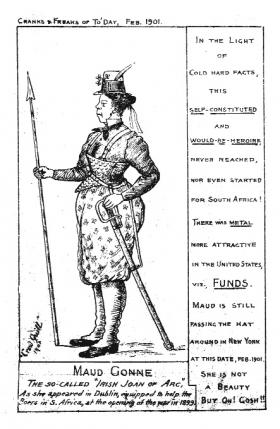
Cartoon satirising Maud Gonne, from her file. (National Archives, Kew)
Most of the files concern republican suspects or victims of republican violence, but a substantial number outline the activities of socialists, trade unionists, feminists, communists and agrarian radicals during a period of disturbed social and economic conditions. For example, Sylvia Pankhurst’s visit to Dublin in 1919 to speak to the Irish Women’s Franchise League was closely observed. There are also files on deserters, suspect foreign nationals, disgruntled policemen, poison-pen letter-writers, swindlers and paranoid fantasists. There are appeals to Dublin Castle for jobs, money, favours and the redress of grievances, real or imagined. The files also contain letters from several informers and would-be secret agents eager to volunteer their services against the IRA. Kahan Singh Chowdhury, an Indian studying in Dublin in 1920, wrote to the chief secretary offering the use of his ‘Eastern brain’ in the campaign against the IRA. Such men were not always suited to their chosen vocation. P. J. Gartland’s request to join the Irish ‘secret service’ was, bizarrely, supported by the police in his hometown of Liverpool despite his prominent hunchback, drink problem and history of mental instability.
The difficulties faced by the police in securing convictions for political crimes are clearly evident, particularly in troubled areas where local justices and juries were reluctant to convict suspects for political offences and witnesses were invariably unwilling to come forward. The files also demonstrate how republican strategies evolved during the Tan War. Whereas the rebels of 1916 responded to defeat in an idealistic (or naïve) manner, defiantly admitting their actions and making little effort to evade capture and punishment, the rules had clearly changed by 1919. Republicans found in possession of incriminating documents denied any knowledge of them, publicly repudiating their political sympathies if necessary. Convicted republicans signed undertakings to abstain from political activism to secure early release without any intention of honouring them. Suspects rarely admitted the charges against them—no matter how strong the evidence—and exploited every legal (or illegal) loophole to avoid prosecution or dismissal.
The RIC undermined
Indeed, it is the increasing inability of the police to respond to the transformed political circumstances that provides the vital context to these files. Before the outbreak of the Great War, the lot of the Irish policeman was not particularly arduous. Although grievances about pay and conditions existed, the police enjoyed a respectable status within their local community. Admittedly, in contrast to the English constabulary, the RIC was an armed force—its 12,000 constables living in military-style barracks outside their home counties for reasons of security and discipline—but it was not generally resented as an alien body, except during periodic outbreaks of political or agrarian tension. The vast majority of RIC men were Catholics—and most, therefore, were nationalists—although the higher ranks of the force, like the judiciary and the upper echelons of the Dublin Castle administration, remained predominantly Protestant and unionist. The force was experienced in dealing with political and agrarian crime and, with its intimate knowledge of the local community, was well placed to chart the volatile political mood of nationalist Ireland. The RIC played a crucial role as ‘the eyes and ears of Dublin Castle’ and symbolised the power of the British Crown in Ireland. For these reasons, the acceptance of the policeman within his community, and his ability to perform his duties, inevitably came under challenge after 1916.
During the War of Independence, the RIC was placed under intense pressure by the republican movement, which identified the policeman as its principal enemy. The police were ridiculed, intimidated and attacked. Public drilling and the intimidation of witnesses and jurors further humiliated the force by demonstrating its inability to preserve order.
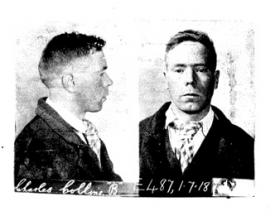
Mug shot of Charles Collins, arrested on 19 May 1918 near Brittas, Co. Wicklow, for carrying sixteen sticks of gelignite and other incendiary equipment. (National Archives, Kew)
The IRA’s most effective weapon was the boycott, which began in the summer of 1918. Policemen were shunned by their neighbours, who refused to talk to them, sit beside them at church or conduct business with them. In reality, the police represented more of a soft target than the cutting edge of British imperialism. Many policemen, the inspector general of the RIC reported, opted to resign rather than live ‘boycotted, ostracised, forced to commandeer their food, crowded in many instances into cramped quarters without proper light or air, every man’s hand against them, in danger of their lives and subjected to the appeals of their parents and their families to induce them to leave’.
Ostracism was followed by assassination. The first meeting of Dáil Éireann in January 1919 coincided with the killing of two policemen at Soloheadbeg, Co. Tipperary, an attack that shocked many nationalists. By 1920 such murders had become commonplace: some 400 policemen were killed during the conflict. The RIC’s strength during times of relative peace—its closeness to the community among whom it lived—became a serious weakness. It was not difficult for determined IRA leaders to cultivate contacts with friendly, frightened or otherwise vulnerable policemen, to intimidate diligent policemen out of their jobs and encourage their less enthusiastic colleagues to remain. A subsequent military report asserted that ‘the police service of information had practically broken down by December 1919, owing to the murder of the best and most active members of the RIC and DMP’. By then, the police had also been seriously penetrated. The IRA recruited confidential clerks and Special Branch detectives as informers, while on one famous occasion Michael Collins spent a night locked inside the records room of the DMP.
The streets of Dublin, however, were the front line in the conflict between the police and the IRA. Well known to their putative targets, the G-men who specialised in political work proved particularly vulnerable to IRA attacks. In mid-1919 Michael Collins formed ‘the squad’ to assassinate these men. The decision was partly pragmatic. Their elimination would remove a vital source of intelligence from the Irish administration, allowing the IRA vital breathing space. But there were also political and symbolic motives. The G-men were the most hated symbols of the British regime, particularly despised for their role in picking out the leaders of the rebellion for execution in 1916.
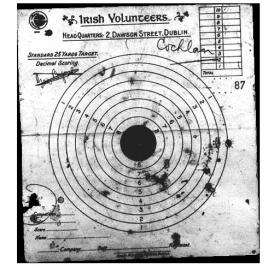
Irish Volunteers’ target-practice sheet found in 1918 in the Larkfield estate home of Grace Plunkett (née Gifford), wife of the executed Joseph Mary Plunkett. (National Archives, Kew)
Their killings could be depicted as justifiable, while the British response to them would escalate the conflict. Between July 1919 and May 1920, a dozen DMP men were assassinated. By the end of the IRA’s brutal but effective campaign, the DMP’s intelligence-gathering capabilities had been destroyed and the force was on the verge of collapse. Remarkably, the DMP was compelled to withdraw from direct involvement in the conflict, its members refusing to carry arms or assume any responsibility for political crime.
The RIC proved more resilient, particularly in terms of morale, but it was placed under enormous strain by the IRA’s campaign. The police increasingly came to view entire communities as hostile. By the summer of 1920, even Dublin’s Mater Hospital appeared a hotbed of intrigue: ‘The community of nuns who manage this hospital, the majority of the medical staff, the nurses and practically all the students are Sinn Féiners or Sinn Féin sympathisers’. These files testify to the RIC’s growing inability to meet the republican challenge. Activists could not be located despite continuing to operate within their own areas. IRA men could not be arrested without military support. Although aware of the identity of many of its enemies, the RIC was unable to gather sufficient evidence to prosecute them. Witnesses would not testify against the IRA, and those who were prepared to do so could not be protected. The police’s authority in rural areas diminished, increasingly displaced by that of the IRA. By 1920 judges were frequently presented with white gloves, signifying not the peaceful state of the country but the RIC’s inability to bring offenders before the courts. Despite misgivings, many RIC men remained loyal to the Crown but—increasingly demoralised and anticipating Britain’s eventual withdrawal—hundreds resigned, looked the other way or defected to the enemy.
These files illustrate the consequent decline of the police’s intelligence capabilities. While many of the earlier files contain detailed and vivid information, the police had clearly lost touch with political crime by 1920. The British Army’s ‘Record of the Rebellion in Ireland’ attributed some of the blame to the RIC’s outdated methods and lack of resources:
‘The Crimes Special Branch depended much more on personal and local knowledge than on organisation and methodical recording . . . The unwise economy which reduced the personnel of the Crimes Special Branch made it almost impossible to keep adequate, up-to-date and reliable records and files. Moreover, nearly every “Crimes Special” report was laboriously written out in longhand and copies were seldom kept. They were passed backward and forward between the central and subordinate officers, thus greatly increasing the opportunities for discovering their contents. The result was that when those men, whose knowledge would have been invaluable during 1920 and 1921, were murdered, the intelligence system in Ireland collapsed for the time being and had to be built up afresh.’
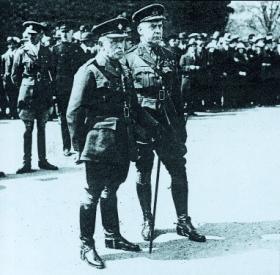
General Sir Nevil Macready (left, with Viceroy Lord French), an officer with a knowledge of both policing and Irish affairs, was appointed general-officer-commanding, Irish command, in March 1920.
The failure of Dublin Castle
Too much responsibility for these shortcomings, however, could be placed on the police, who had little influence over the policies they were expected to execute. Until mid-1920, no coherent security policy was put in place either by the British government or its administration at Dublin Castle, which was regarded by many of the politicians and civil servants who worked within it as dysfunctional and chaotic. The superficially orderly appearance of the Personalities Files masks the confusion that reigned within Dublin Castle. Closer scrutiny provides many examples of these problems. Cooperation and coordination between the army and the police were poor and relations were often strained—as is revealed by such incidents as the forced resignation of the RIC’s county inspector for Londonderry, ‘who has not the confidence of the military’, or the police’s anger at the army’s failure to come to its assistance following the murder of a sergeant in Clare. Police advice to Dublin Castle, whose approach oscillated between conciliation and coercion, was frequently ignored: leading republican activists were often released by Dublin Castle despite the RIC’s opposition. The resulting tensions between the demoralised police force and Dublin Castle were reflected by the poor relationship between the staunchly unionist lord lieutenant, Field Marshal Lord French, and the inspector general, General Joseph Byrne, until the latter’s acrimonious removal from office.
Few of these files concern the final twelve months of the conflict, the period when the British cabinet applied serious effort and resources to the Irish crisis. The appointment of a military officer, Major-General Hugh Tudor, as chief of police signalled a decision to militarise the embattled police force. General Sir Nevil Macready, an officer with a knowledge of both policing and Irish affairs, was appointed general-officer-commanding, Irish command, in March 1920. The RIC was opened to non-Irish recruits, resulting in an influx of demobilised British soldiers (soon known as ‘Black and Tans’) into the force. These men, and the more effective Auxiliary Division, would earn a notorious reputation for their involvement in reprisals such as the murder of the Sinn Féin lord mayor of Cork, Thomas MacCurtain, and the burning of Cork city. The time-consuming process of gathering evidence for often fruitless civil prosecutions to which many of these files bear testimony was bypassed in favour of an aggressive counter-insurgency campaign relying on martial law, internment and an increasingly dirty undercover war. The RIC’s intelligence role was superseded by a reorganised intelligence branch under Brigadier-General Ormonde Winter. These changes placed the IRA under greater pressure but alienated moderate nationalist opinion and shocked international and British opinion, thereby increasing the pressure on both sides for a negotiated end to the conflict. They also spelled the end of the old RIC, many of whose members resented service alongside their less disciplined comrades and the aggressive policies they were now expected to execute.
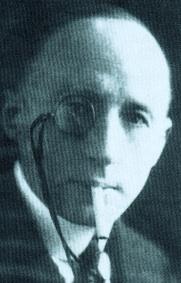
The RIC’s intelligence role was superseded by a reorganised intelligence branch under Brigadier-General Ormonde de l’Epee Winter.
The Personalities Files provide a valuable insight into the final years of that force, illuminating diverse aspects of the Irish revolution. For students of the Irish revolution, they represent a rich source of information about the social and political unrest of the last decades of British rule in southern Ireland. The files provide valuable and often vivid insights into the challenges facing the British administration and the background and activities of the young men and women who fought Britain’s Crown forces to a stalemate by the summer of 1921.
Fearghal McGarry lectures in history at Queen’s University, Belfast.
Further reading:
P. Hart (ed.), British intelligence in Ireland: the final reports (Cork, 2002).
E. O’Halpin, The decline of the Union (Dublin, 1987).
C. Townshend, The British campaign in Ireland, 1919–1921 (Oxford, 1975).
















